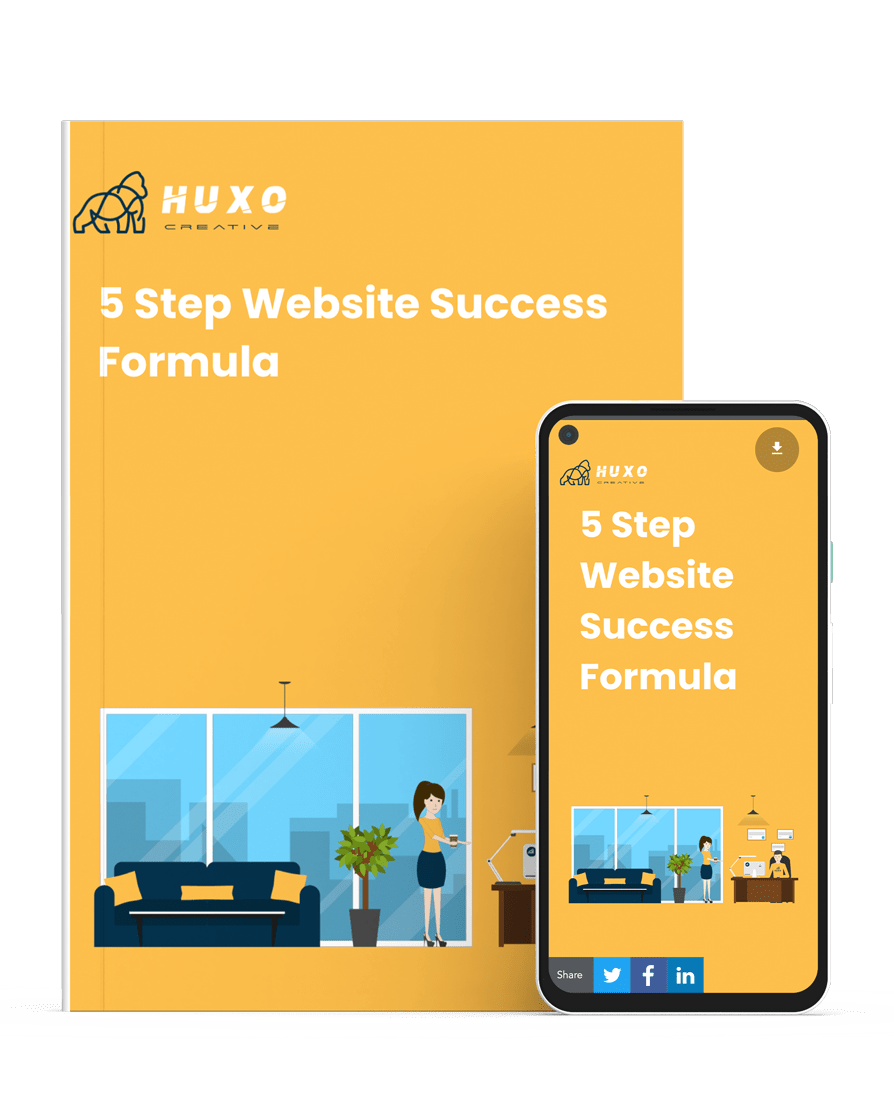A quick Google search will bring up no end of posts about websites and website design. You’ll find stacks of information about the types of pages you need, lead magnets, blog posts, landing pages. And I could go on.
In this article we're going to teach you how to build an effective website that generates revenue. We’ll put some meat on the bones and tell you exactly what your website actually needs to add real value to your business.
75% of users admit to making judgements about a company’s credibility based on their website’s design – Stanford Persuasive Technology Lab
“It would be great if companies could just magically know what I'm looking for on their website or what I'm coming to the website for.” – Alfred Lin
What you’ll learn:
- Poor design and cheap work costs your business A LOT of money
- You're not focusing on the right area
- How to get your visitors to take the next step
Bad website design is expensive
Some people believe websites only need to cost £500 – £1000. Recently I bumped into an old friend and business owner who told me “My friend’s cousin designed our new website for a few hundred quid”.
Now I'm sure his friend’s cousin designs pretty websites, but if the websites he builds talk to the target audience, take the customer on a journey, and generate revenue for the businesses he builds them for, then he should be charging a decent amount of money for them. He should definitely be charging enough to earn a living and stay in business. What if he builds the site and disappears a year later? What if he's the only person able to edit or maintain the website and he can't afford to be in business for long? You'll have to start from scratch or bring in a professional.
Have you heard of the accounting whizz and that amazing graphic designer who’ll work for exposure? Me neither! Although they’re both skills anyone can learn easily, but they’re far from easy to master. It’s true that you get what you pay for.
How much does a house cost? A £200k house is going to be completely different to a £2m house.
Brochure websites just won’t cut it these days
Gone are the days where just having a website was fine. If your website is going to be a genuine addition to your business then it should be an asset, providing measurable impact on your profits. New leads, sales and better relationships with your customers.
Just having a website isn't enough for your business. You need to be producing relevant content for your audience on a regular basis. That should be your number one focus, helping your audience and being useful and valuable to them.
Not understanding who it is you’re aiming to speak to will massively hamper your efforts. Trying to target EVERYONE or get everyone to donate isn’t going to bring in a flood of donations, no matter how important your cause is. You need to understand your target audience and speak to them, be useful to them, and provide them with interesting, relevant content. If they find it useful, others will too.
You're having to compete with so much more now. Distractions are everywhere on the internet and everyone is fighting to get the attention of your audience. Providing useful, interesting content that people want to read, watch, and listen to helps you stand out. It’s that simple.
And the icing on the cake? You need to collect email addresses of customers and new leads and market to them effectively. Your website can only get you so far. But what it can do is SERIOUSLY top up your email list with people willing to give you money.
Content is becoming crucial to the purchasing process:
9 out of 10 B2B product or service buyers say that online content has had a moderate to major impact on their purchasing decisions – Lenati
3 Ways Businesses Fail With Their Website
1) Failing to update or maintain websites
Sometimes the simplest issue to fix with a website (and something that everyone will experience at some point), is a website that doesn’t work.
It could be hosted on a server that isn’t good enough or fast enough. Images may not have been optimised properly for the web, leaving them too big and causing the website to load too slowly.
If your hosting is poor or if your site isn’t optimised properly your website isn’t going to load fast enough. If it takes more than just a few seconds your visitors will leave and go elsewhere, plus Google will penalise you for a having a slow website, the same as they do for websites that aren’t mobile-friendly.
‘Broken code' will also harm your website. There’s an endless list of things that could break on your website but typically website updates, core software updates, and changes to the platform can all break a website, even if it was working fine prior to any changes.
The fact is if you don’t pay for a backed up, properly updated, and well maintained website, then your website WILL have problems and it WILL BREAK eventually..
Lastly, the most common reason sites break or slow down is because they're not properly secure. Because users (yes, I’m talking to you) don't change their passwords or because they don't pay for adequate hosting or proper maintenance, malicious people and malicious code will end up getting into your website and they’ll ruin it.
Sometimes you won't even notice it, but visitors to your website will. Malware can be hard to spot, a massive turnoff for visitors and a pain to remove.
This isn’t rare, it happens regularly and it happens everywhere. Luckily, it’s not difficult to prevent. Unfortunately, it is much harder to fix, along with your reputation if your customers' information gets exposed. The choice is yours.
More than 80% of the websites that are hacked is because they were not being updated – Malcare.com
2) Failing to focus on the right content
You’ve probably seen it yourself; business websites, designed to sell products or services to other businesses, feeling the need to tell you what each member of their team does in their own time, the more out there the better.
“When he’s not in the office crunching the numbers on your accounts, William loves nothing more than making his own soap from his own leftover artisan coffee beans that he handpicked and washes whilst backpacking in Cape Verde”.
Now, well done to William for having a hobby, but none of that is relevant. How about something closer to the truth? “When he’s not sat at his desk checking Facebook or doing his weekly shopping, Rich can be found having a cheeky smoke outside with his colleagues or chatting up the new girl on reception”.
At a more relatable level, we see loads of businesses writing about and publishing content aimed at the wrong people.
Your content should talk to your audience.
If you’re trying to generate sales, talk about the benefits your product offers, or how to use your product. Explain to customers exactly what their money will pay for. If you're a business coach, put out content that will help your customers. Talk about how they can improve their business, give them steps to take.
Don't be like other businesses, don’t talk about things that would appeal to other people working in other businesses like yours. We see so many businesses create content that would be better suited to be read by their peers and competitors. Write for the people you serve.
3) Failing to produce enough content
Finally, and we see this happening all of the time, you need to create content on a regular basis and keep your website updated. It’s easy to lose steam a few months after your website has launched. Sometimes you’ll be stuck for what to write, there’ll times when you just don’t have the time.
It’s important to put relevant, valuable content out regularly. It sounds difficult, but it’s not once you have a solid process in place to create new content. If you’re struggling with what to come up with or how to put it together, we can help. If you genuinely don’t have anything to say, what is your organisation actually doing?
Put useful content out that your audience wants to read about, watch, or hear. I guarantee you’ll have more content than you realise right now, sometimes it’s just about getting that content out of your head and written down.
Let us help you find it and get it to work for your business, generating sales and helping you reach a wider audience.
Blogs have been rated as the 5th most trusted source for accurate online information – HubSpot
3 Steps To Turn Your Website Into A Marketing Machine
Step 1) How to post new content regularly
First of all, you need to commit to producing one new piece of content every week. It's that simple. And if you have a system and a plan, it’s not as scary as a sounds.
An easy way to kick this off now is to write down five broad topics that your target audience wants to hear and that you can talk about.
So, if you’re a chiropractor, think about five basic topics that come up between you and your patients or five topics you could put everything under. For instance, back pain in pregnancy, lower back pain, sports injuries, exercises to ease back pain, and back pain home remedies.
What are the most commonly asked questions you’re asked about each of those topics? What do you get calls and emails about the most? What things do you find yourself having to explain over and over again to different people?
Every one of those questions could be a blog post or you could create a frequently asked questions post to point people towards.
Have a think about topics your customers SHOULD know about. What would they need some help with? Think about thinks that they normally only find out about once they become more involved. Tell stories, talk about the good you’ve done and about how you’ve helped others. Let people know how they can get involved and help in the community.
What makes your business different? Why should anyone be compelled to help you? Tell people. Make sure you talk about YOUR business and what makes you different. Who are the people involved in your company and what do they think about the broad subjects?
Even if you only come up with three questions for each of your five broad topics, that's fifteen pieces of content already.
Step 2) How to tell website visitors what action to take next
So, someone has read your post (high five!) and now we want their details. The aim here is to want them to give you their email address and contact details so you can market to them. How do you get them to hand over their information? You offer them another useful, highly valuable piece of content in return for their email address.
Ask them: “If you liked this post about [topic], then you're going to love our podcast/ebook/guide/video on [topic]”.
Make them want what you’re offering, make it worthwhile. Focus on the value they’ll get by handing over their email address and showing them what they can do after they sign up.
What would be the next logical steps for someone after reading your blog post? For example if I'm reading a post about setting up a WordPress website, the next step could be a guide on how to get WordPress installed and setup properly.
Your next step should be related to the original content they’re consuming. Make it a next step or an added bonus. What would someone REALLY want to read or do next if they were reading your awesome content?
Step 3) How to keep it super simple.
Don't over complicate your website design. White space is good. Too much cluttered text puts people off. Make it easy for people to use and read your content by keeping white space and keeping it uncluttered.
Limit the colours you use to a few per page – A common misconception is that good design is a lot of good colour. It isn't, it's few colours used well. Don't overdo it, less is definitely more in this instance.
- Good images are nice – When you can’t use real photos spend 15 minutes or so to find high quality stock images (they can even be free from the likes of Pixabay, Pexels, Unsplash or bought from Shutterstock or DepositPhotos) and help people visualise the story you're telling them.
- Break the text up – People skim posts to find what they’re looking for. Keep it minimal, whatever the length of your post, and separate out points. Prioritise what points you want to get across.
- Focus on one Call To Action for each post/page – Don’t ask your reader to do more than one thing, they’ll end up doing none of them. Make it easy for them to take the action you want them to take next. Something like ‘download a free guide’ or ‘book a call’, not both. Don't over complicate it.
Summary
We love the idea of saying “if you liked that, you'll love this” for next steps. We use it on landing pages and blog posts all the time.
A lot of customers ask us “well why should we pay £5000 for our website if this guy down the road will do it for £500?” And we do understand what you're saying but what our customers have found is that they don't have to pay for expensive fixes to their site if they invest properly in a website that generates revenue.
Like most things in life you need to input a certain amount before you get anything out. You have to invest to receive.
Takeaway
- Don't pay for cheap websites because they’ll cost you more in the long run.
- Good design that generates a return is simple, not complicated.
- You need to regularly create valuable content that your audience wants to read.
















